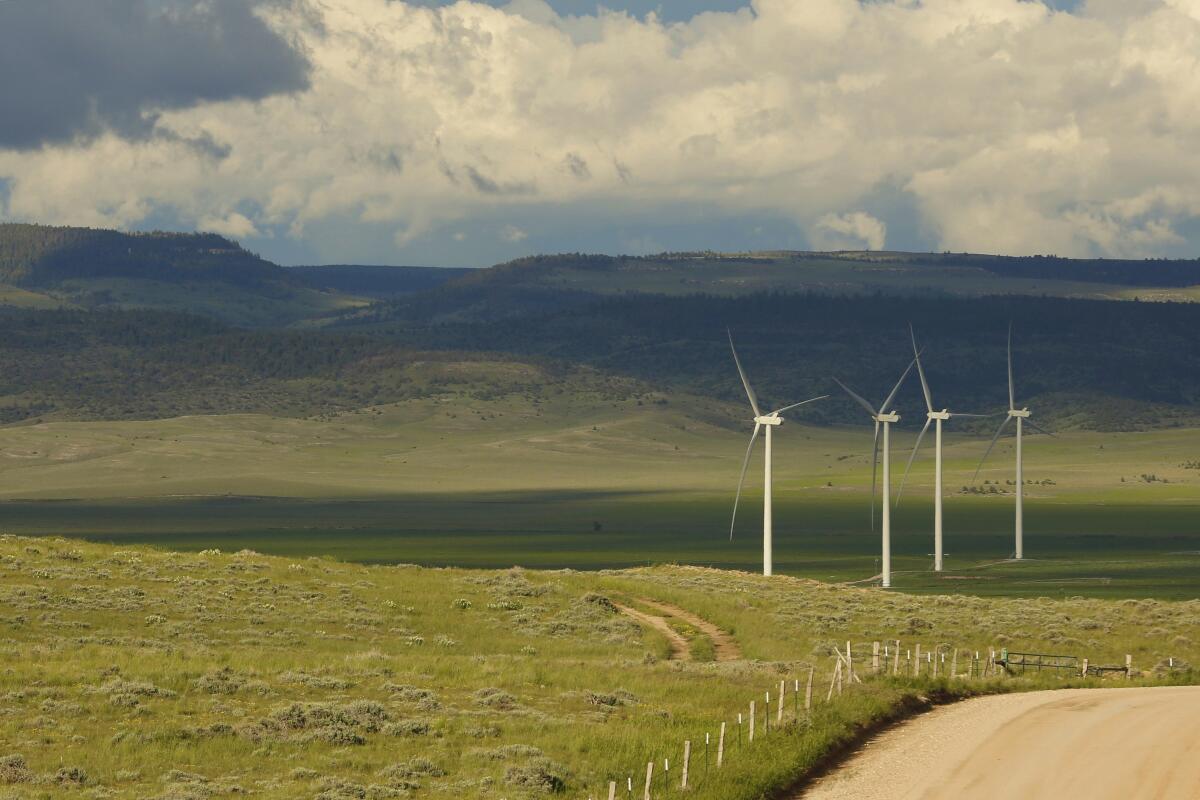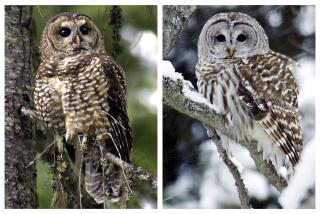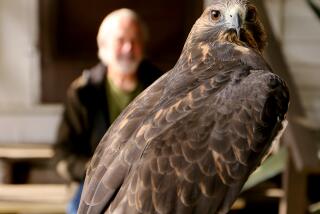Wind energy boom and golden eagles collide in the American West

- Share via
CODY, Wyo. — The rush to build wind farms to combat climate change is colliding with preservation of one of the U.S. West’s most spectacular predators — the golden eagle — as the species teeters on the edge
of decline.
Ground zero in the conflict is Wyoming, a stronghold for golden eagles that soar on seven-foot wings and a favored location for wind farms. As wind turbines proliferate, scientists say, deaths from collisions could drive down golden eagle numbers, which are considered stable at best and likely to drop in some areas.
Yet climate change looms as a potentially greater threat: Rising temperatures are projected to reduce breeding ranges of golden eagles by more than 40% later this century, according to a National Audubon Society analysis.
That leaves the species doubly vulnerable: to the shifting climate and to the wind energy promoted as a solution to that.
“We have some of the best golden eagle populations in Wyoming, but it doesn’t mean the population is not at risk,” said Bryan Bedrosian, conservation director at the Teton Raptor Center in Wilson, Wyo. “As we increase wind development across the U.S., that risk is increasing.”
Turbine blades hundreds of feet long are among myriad threats to golden eagles, which are routinely shot, poisoned by lead, struck by vehicles and electrocuted on power lines.
The tenuous position of the eagles contrasts with the conservation success of their cousins, bald eagles, whose numbers have quadrupled since 2009. There are about 350,000 bald eagles in the U.S., versus about 40,000 golden eagles, which need much larger areas to survive and are more inclined to have trouble with humans.
Federal officials have tried to curb turbine deaths while avoiding slowdowns in the growth of wind power — a key piece of President Biden’s climate agenda.
In April, a Florida-based power company pleaded guilty to criminal charges after wind turbines killed more than 100 golden eagles in eight states. It was the third conviction in a decade of a major wind company for killing eagles.
Dangling from a rope 30 feet above the ground, with a canvas bag slung around his neck, Bedrosian shouldered his way into a golden eagle nest lodged in a cliff ledge. The scientist made an awkward grab for the young eagle in the nest, slid a leather hood over its head, then wrestled it into the bag.
The 6-week-old eaglet was lowered and carefully extracted by Bedrosian’s colleague, Charles Preston, a zip tie around its feet as a precaution against inch-long talons.
“The key is not to forget later to cut the zip tie,” Bedrosian said.
The eaglet went on a scale: about seven pounds. Bedrosian drew blood from a wing to test for lead exposure, and Preston clamped a metal identification band onto each leg.
Golden eagles don’t mate until they are about 5 years old and produce about one chick every two years, so adult eagle deaths have outsize effects on the population, said Bedrosian.
Illegal shootings are the biggest cause of death, killing about 700 golden eagles annually, according to federal estimates. More than 600 die annually in collisions with cars, wind turbines and other objects.
“Wind mortality wasn’t a thing for golden eagles 10 years ago,” Bedrosian said. “I don’t want to pick on wind as the only thing. ... But it’s the additive nature of all these things, and several are increasing. Vehicle strikes are increasing. Climate change is increasing. Wind is increasing.”
The recent criminal prosecution of a NextEra Energy subsidiary offered a glimpse into the problem’s scope.
The company was ordered to pay more than $8 million in fines and restitution for killing eagles at wind farms in eight states.
NextEra remained defiant after the plea deal: Its president said bird collisions with turbines were unavoidable accidents that should not be criminalized.
Duke Energy and PacifiCorp previously pleaded guilty to similar charges in Wyoming. North Carolina-based Duke was sentenced in 2013 to $1 million in fines and restitution and five years of probation following the deaths of 14 golden eagles; a year later, Oregon-based PacifiCorp was sentenced to $2.5 million in fines and five years of probation over 38 killed eagles.
The number of wind turbines nationwide more than doubled over the last decade to almost 72,000, according to U.S. Geological Survey data.
To control the impact on eagles, federal officials want companies to obtain permits that allow them to kill some birds if the deaths are offset. Companies then pay utilities to retrofit power poles, so eagles can’t be easily electrocuted. Every 11 poles retrofitted typically count as an eagle death avoided.
Nationwide, 34 permits last year authorized companies to “take” 170 golden eagles — meaning birds killed by turbines or lost through impacts on nests or habitat. A public records review shows that most of the companies are wind farms.
“This sounds crass, but it’s realistic. Eagles are going to be incidentally killed at wind farms,” said Brian Millsap, who heads the U.S. Fish and Wildlife Service’s eagle program. “We’ve got to reduce other things that will allow wind energy development.”
The nests where Bedrosian and Preston are conducting population studies are about 60 miles from the nearest wind farm: 114 turbines that PacifiCorp began operating about two years ago near the Wyoming-Montana border. Personnel on the site scan the skies with binoculars for eagles and can shut down turbines when they approach.
“We tend to see more golden eagles in prairie areas, where you’re going to have the best wind regimes,” said Travis Brown, a biologist with PacifiCorp. “It’s almost like competition for the wind resource, because the birds are using it for movement.”
Ten PacifiCorp wind farms have permits authorizing the incidental killing of eagles, according to the company.
Company representatives declined to say how many eagles have died under its federal permits. They said PacifiCorp has been building a “bank” of retrofitted power poles to offset eagle deaths and wants to try new approaches, such as painting turbine blades so they are more visible and easier for birds to avoid.
“We’re working as hard as we can to avoid and minimize [deaths] up front, and then anything we can’t we’re mitigating on the back end,” Brown said.
More to Read
Sign up for Essential California
The most important California stories and recommendations in your inbox every morning.
You may occasionally receive promotional content from the Los Angeles Times.










